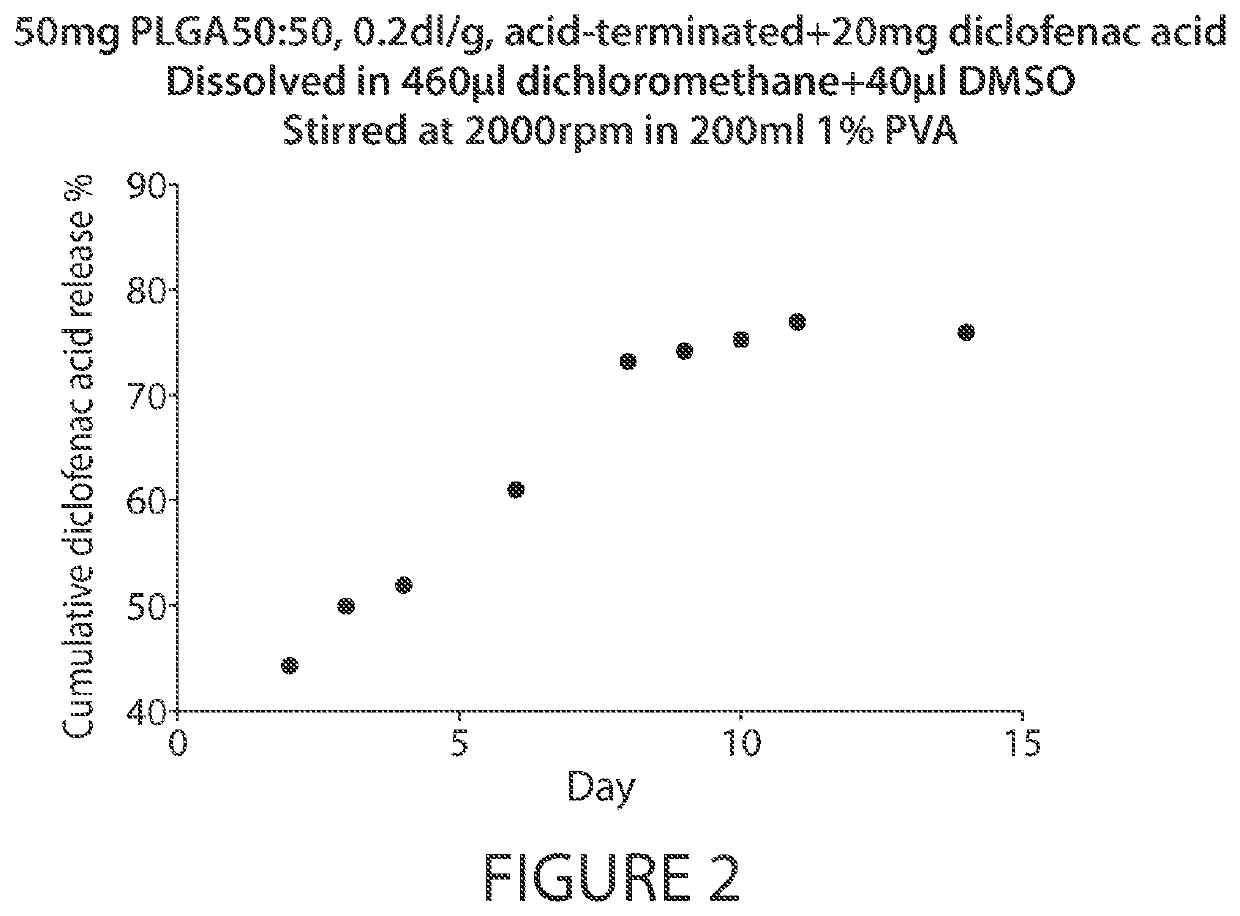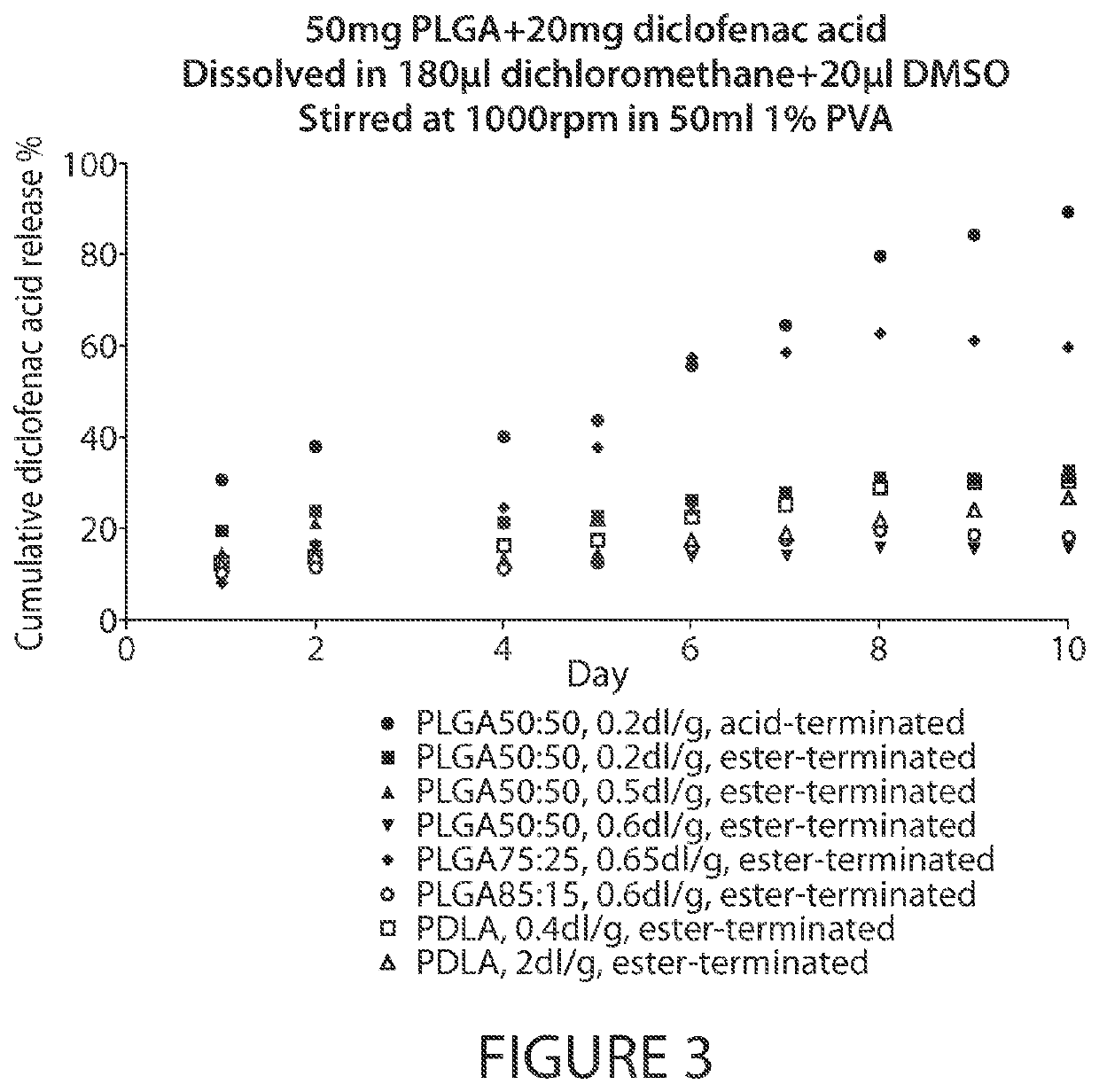Microsphere-Based Injectible Celecoxib Formulation
a celecoxib and microsphere technology, applied in the direction of capsule delivery, microcapsules, drug compositions, etc., can solve the problems of unsuitable pharmaceutical depot formulations, significant cardiovascular side effects, and the vast majority of nsaids causing severe side effects
- Summary
- Abstract
- Description
- Claims
- Application Information
AI Technical Summary
Benefits of technology
Problems solved by technology
Method used
Image
Examples
example 1
tal Materials and Methods Generally
[0177]PLGA refers to poly-lactic-co-glycolic acid; PDLA refers to poly-D-lactic acid, which is one kind of poly-lactic acid (PLA); DMSO refers to dimethyl sulfoxide; PVA refers to poly-vinyl-alcohol, molecular weight: 31-50K, 98-99% hydrolyzed; PBS refers to phosphate buffered saline, pH 7.4; and MW refers to molecular weight. The magnetic stir bar used in all of the following examples is 2 cm in length and 0.7 cm in diameter.
[0178](i) PDLA, 0.4 dl / g, ester-terminated: Intrinsic viscosity=0.35-0.45 dl / g. MW: 20,000-30,000; (ii) PDLA, 0.6 dl / g, ester-terminated: Intrinsic viscosity=0.55-0.65 dl / g; (iii) PDLA, 2 dl / g, ester-terminated: Intrinsic viscosity=1.6-2.4 dl / g. MW: 300,000-600,000; (iv) PLGA50:50, 0.2 dl / g, acid-terminated: Intrinsic viscosity=0.16-0.24 dl / g. MW: 7,000-17,000; (v) PLGA50:50, 0.2 dl / g, ester-terminated: Intrinsic viscosity=0.16-0.24 dl / g. MW: 7,000-17,000; (vi) PLGA50:50, 0.4 dl / g, acid-terminated: Intrinsic viscosity=0.32-0.4...
example 2
re Formulations of Diclofenac Acid: Effects of Polymer Composition on Diclofenac Acid Release (I)
[0180]A pharmaceutical depot was prepared comprised of the NSAID, diclofenac acid (2-[2-(2,6-dichloroanilino)phenyl]acetic acid), incorporated into microspheres. Formulations were prepared by dissolving 50 mg of PLGA or PDLA and 20 mg of diclofenac acid in 440 μl of dichloromethane and 60 μl of DMSO. The 500 μl of solution was injected into the center of 200 ml of 1% PVA (w / v, pH adjusted to 2) in a 250 ml beaker, stirred at 2,000 rpm with a magnetic stir bar to form an emulsion. The emulsion was stirred at 2,000 rpm for 2 minutes and stirred at about 500 rpm for 2 hours to evaporate the dichloromethane. The microspheres were harvested by centrifugation at 4,000 g for 5 minutes, washed with water for three times.
[0181]For testing diclofenac acid release from the microspheres, all prepared microspheres were added to 250 ml of 10 mM PBS and shaken at 80 rpm at 37° C. At each time point in ...
example 3
re Formulations of Diclofenac Acid: Effects of Polymer Composition on Diclofenac Acid Release (II)
[0184]In another set of experiments, formulations were prepared by dissolving 5 mg of PLGA or PDLA and 2 mg of diclofenac acid in 180 μl of dichloromethane and 20 μl DMSO. The 200 μl of solution was injected into the center of 50 ml of 1% PVA (w / v, pH adjusted to 2) in a 50 ml beaker, stirred at 1,000 rpm with a magnetic stir bar to form an emulsion. The emulsion was stirred at 1,000 rpm for 2 minutes and stirred at about 500 rpm for 2 hours to evaporate the dichloromethane. The microspheres were harvested by centrifugation at 4,000 g for 5 minutes, washed with 50 ml water for three times.
[0185]For testing diclofenac acid release from the microspheres, all prepared microspheres were added to 250 ml of 10 mM PBS and shaken at 80 rpm at 37° C. At each time point in the release study, microspheres were allowed to settle, and an aliquot of 650 μl was taken for measuring UV absorption and ad...
PUM
| Property | Measurement | Unit |
|---|---|---|
| Length | aaaaa | aaaaa |
| Length | aaaaa | aaaaa |
| Time | aaaaa | aaaaa |
Abstract
Description
Claims
Application Information
 Login to View More
Login to View More - R&D
- Intellectual Property
- Life Sciences
- Materials
- Tech Scout
- Unparalleled Data Quality
- Higher Quality Content
- 60% Fewer Hallucinations
Browse by: Latest US Patents, China's latest patents, Technical Efficacy Thesaurus, Application Domain, Technology Topic, Popular Technical Reports.
© 2025 PatSnap. All rights reserved.Legal|Privacy policy|Modern Slavery Act Transparency Statement|Sitemap|About US| Contact US: help@patsnap.com



